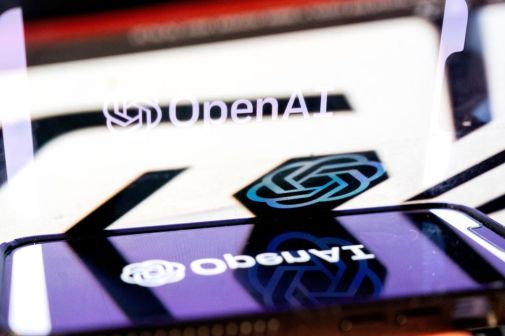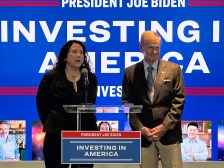The concept of mobility in government is more than just having a smartphone in your hand when you go from meeting to meeting; it’s the ability to make information accessible on mobile devices, securely. FedScoop asked a handful of thought leaders to grade how mobile the government is, judging on a scale of 1 to 5, with 5 being the best.
 Kimberly Hancher, CIO, Equal Employment Opportunity Commission:
Kimberly Hancher, CIO, Equal Employment Opportunity Commission:
Score: 3
Mobility in government is not just about digitization of documents; it is about changing the way you do business. For federal CIOs and their IT department, it is about providing secure, reliable remote access to the agency IT services and empowering federal workers to use their device of choice to get work done. Work productivity depends heavily on access to information, and we are just beginning to grasp the need to move on from ‘device control’ and begin focusing on ‘data governance.’ So ‘mobile government’ is not just about hardware and security. It is all about embracing the fact that ‘work’ is not a place you go — it is the thing that you do!
Michael Valivullah, CTO, NASS, Agriculture Department:
Score: 3
Almost every agency can function reasonably well when the federal government has to shut down for weather or other reasons. The Federal Telework Program has been a great success. A few years ago, people complained loudly when the federal government shut down for snow or bad weather. This does not happen anymore. In the federal government, some agencies are at the forefront, blazing the trail and sharing their experiences — successes as well as challenges. There is quite a bit of knowledge sharing that takes place between agencies in mobility related meetings, conferences, seminars, etc. OMB, OSTP, Federal CIO council, NIST, GSA and others have been helping agencies to move forward and expand mobility, cloud, digital strategy, open government, etc. More and more tools, technologies, standards and best practices are becoming available at a reasonable cost agencies can afford. Many private industry partners have helped the feds successfully meet agency specific mobility challenges. Many legacy federal business processes are being redefined and refined to increase efficiency, reduce cycle time, increase effectiveness and increase customer satisfaction. Federal agencies are sharing experiences, frameworks, guidelines and examples with other agencies to architect solutions to achieve their mission. Agencies are setting up mobile app stores, rolling out MDM, MAM solutions, etc., to make their mobile operations secure, efficient and effective, reduce risk and cost, and enhance service to the citizens.
Scott Horvath, bureau social media lead, Office of Communications and Publishing , U.S. Geological Survey:
, U.S. Geological Survey:
Score: 3
I would say a solid 3, but there’s plenty of room to grow within each ranking. Being a mobile government isn’t always just about having a mobile website or building an app for a smartphone; it’s just as much about mentally thinking mobile and establishing processes to become more mobile. Agencies are pushing hard to make more of their data available in multiple formats. They’re thinking about methods for creating data that are easily consumable by any application, device or technology. I think government is doing a good job of ‘thinking’ mobile. If they’re thinking mobile, then they’re enabling mobile government… whether they’re creating the end product that the consumer uses or not.
 Dan Barahona, senior vice president, strategy and business development, WatchDox
Dan Barahona, senior vice president, strategy and business development, WatchDox
Score: 2/3
I’d rate government mobile adoption a 2 or 3. Yes, nearly every government employee carries at least one mobile device, but the usage is generally limited to voice and email. Mobile employees need access to information, documents and critical apps. We are seeing accelerating adoption of mobile content and file sharing solutions that enable mobile workers the ability to access, edit and share information securely and efficiently on any device.
David Bray, CIO, Federal Communications Commission
Score: 2
I would say that most of government is 2 — lots of opportunities for improvements and innovation in what we do. I would say that the FCC was also 2 until last month, when we started to roll out virtual desktop to enable folks to access their FCC desktop anywhere securely, on a tablet, on a home PC, on a device that they bring to work. That now puts us at 3.5 — above average, again with opportunities for even more improvements ahead.
Mika Cross, workplace transformation strategist, President’s Management Council interagency fellow, Office of Personnel Management
I certainly believe that the government is a 4 out of 5 on the scale of mobility — through remote access technology, mobile device management and new federal policies and updated training to support a modern, mobile workforce, the government is embracing mobility, telework and tools to equip and enable the workforce to do their work smarter, more efficiently and effectively.
Roger Baker, chief strategy officer, Agilex, former CIO at the Department of Veterans Affairs
Federal agencies have been fairly aggressive in their adoption of iOS and Android devices. Unfortunately, the business case is limited too often to BlackBerry replacement, rather than capitalizing on the devices to advance the mission in new ways. There are exceptions, such as Amtrak and VA, which Apple CEO Tim Cook recently recognized for their transformative work in mHealth.
Gwynne Kostin, director, Digital Services Innovation Center, Office of Citizen Services & Innovative Technologies, General Services Administration
Score: None provided
‘How mobile is government?’ is a huge question, but it is somewhat backward. It’s not government that is mobile, but the
people who are accessing the information and services. It’s not government that is mobile, but the information and services that are being accessed by those mobile people. To a large degree, government is mobile — period. People are accessing information on their mobile devices because that’s what they do. Government information may or may not be well-prepared for that access, but it is being done.









